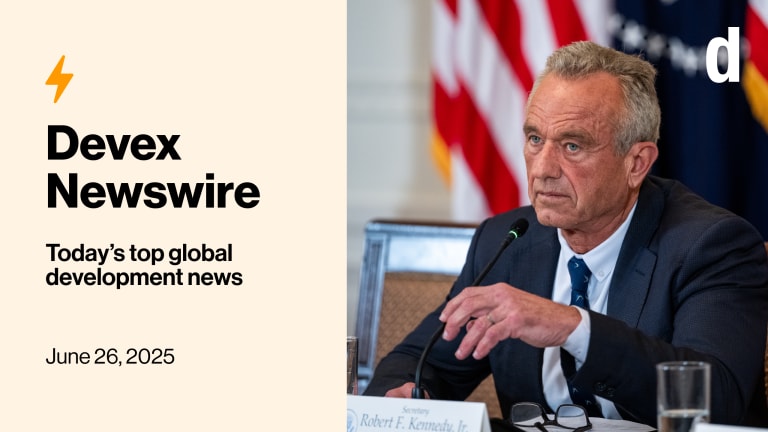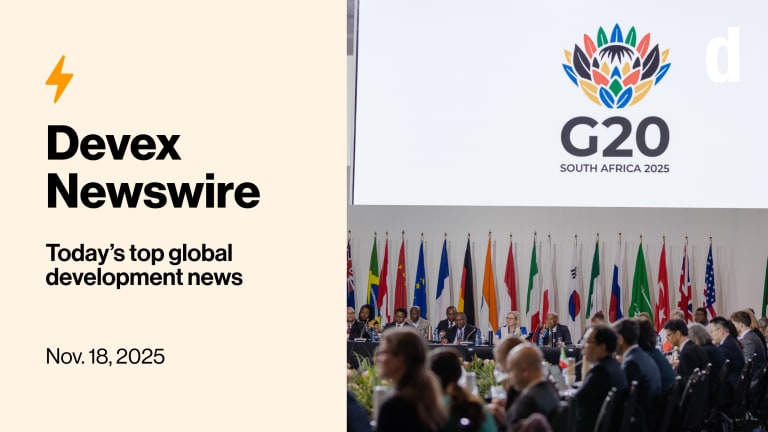
Half a billion dollars. To some people — including us here at the Devex newsroom — that’s a lot of money. For hungry children in need, it’s huge. We have the latest on a surprising uptick in malnutrition funding and the challenges for the makers of peanut paste.
This is a preview of Newswire
Sign up to this newsletter for an inside look at the biggest stories in global development, in your inbox daily.
Also in today’s edition: Will Gavi, the Vaccine Alliance support a plan to roll out hepatitis B vaccinations at birth? A proposal delayed by the COVID-19 pandemic is still up in the air.
A windfall for malnutrition
“It cannot be overstated what a big deal all the money is,” my colleague Teresa Welsh tells me. We were discussing her latest piece diving into the unprecedented amount of donor money flowing into fighting malnutrition. It comes during a year where inflation has grabbed headlines and the cost-of-living crisis is causing real hurt.
For those who were already on the brink, the war in Ukraine, coming after the COVID-19 pandemic, pushed many over the edge. Over the next 12 months, more than 10 million children in the 50 lowest-income nations will require wasting treatment — help for the most severe malnutrition.
Much of the financing push has come from the U.S. Agency for International Development. Agency chief Samantha Power this year announced two large splashes of money, worth a combined $530 million, for ready-to-use therapeutic foods, or RUTFs, a high-calorie peanut paste. USAID's put up almost two-fifths of the sum from its own accounts while the remainder comes from philanthropies and other sources.
However, money can’t fix everything. RUTF manufacturers are struggling to keep up with the increased demand. One big thing that would help is making the donations less sporadic, and more telegraphed, so that the companies producing the paste can be prepared.
“Nobody can give RUTF producers more than a 12-month horizon on how many orders will come through, because it is unpredictable by virtue of the fact that financing is unpredictable,” says Saul Guerrero Oteyza, a UNICEF adviser.
Read: It's a banner year for malnutrition funding. But challenges remain
ICYMI: Unprecedented $280M raised for child malnutrition treatment
Big spenders
Speaking of USAID, where is the agency going to use its money in 2023? Miguel Antonio Tamonan breaks down the first funding forecast for Devex, noting two key figures: 258 opportunities, worth $33.7 billion.
Notable big spending plans include: $300 million for HIV and tuberculosis in South Africa, a similar amount focused on locally led solutions for climate-related disasters, and another tranche of the same amount for TB assistance to ministries of health.
Also, the agency plans to allocate up to $500 million for its business services and IT infrastructure, including upgrades.
Dive in for more details, as the business forecast is now 22.7% more than the same quarter in fiscal year 2022.
Read: USAID business forecast for Q1 2023 (Pro)
+ Try out Devex Pro Funding today with a free five-day trial, and explore funding opportunities from over 850 sources in addition to our analysis and news content.
Vaccine delayed. Vaccine denied?
COVID-19 caused so many disruptions. For countries needing support to roll out hepatitis B vaccinations, the pandemic also meant a plan from Gavi to roll out vaccinations at birth got put on hold. Now, a coalition of health groups is asking the vaccine alliance to put the pedal to the metal.
“The mortality from hepatitis B is so huge. We just feel that this needs to be prioritized and not delayed any longer,” says Cary James, chief executive officer at the World Hepatitis Alliance. James tells my colleague Jenny Lei Ravelo that 260,000 children were born with or acquired hepatitis B at birth in 2021 — a staggering figure.
James hoped the issue would be taken up by the Gavi board this week, but a spokesperson tells Jenny that the pause on introducing new vaccines to the Gavi portfolio "continues" and will be discussed again in mid-2023.
With the delays, health groups fear that the rollout will not take place until post-2026.
“If they start to reassess the process again in 2024, I mean that means there’s nothing that's going to be implemented until post-2026,” James says.
Read: Health groups ask Gavi to start delayed hepatitis B vaccinations
Our top 10
As we promised yesterday, we will be sharing our top 10 most-read opinion pieces of the year daily. No. 2 from the Devex Global Voices 2022 series comes from Sadie Collective’s Funke Aderonmu and economist Phelisha Midy who lay out reasons why Africa food security solutions should prioritize women and girls.

Ken-ya get a loan
Nairobi has opened talks with the World Bank for a $750 million concessional loan, a cabinet official said this week. The move reflects the worsening levels of debt unsustainability in the East African nation, a linchpin of regional economic growth and stability. The loan could be used to help the country pay down high-interest loans and refinance.
Talks are ongoing, sources at the lender confirmed to me, even if they won’t comment on an exact figure yet. However, Kenya is not alone in facing a debt squeeze. As we reported this week, the World Bank is warning on massive levels of external debt across lower-income nations. China is pulling in about 66% of all repayments on official bilateral loans from the world’s low-income nations.
ICYMI: World Bank warns of 'intensifying' debt crisis for poorest nations
Good COP
While the COP 27 climate summit in Egypt got a bunch of headlines and dominated the news cycles for two weeks, the COP 15 biodiversity conference in Canada is no less important and the world “will be tested” during the talks, Jeffrey Parrish of The Nature Conservancy writes in an op-ed for Devex.
There is a risk of a “meltdown” in terms of the services provided by the natural environment, including mitigation against climate change, he says.
A key outcome of COP 15 on biodiversity is progress on the 30X30 goal to protect at least 30% of the planet’s land, freshwater, and oceans by 2030. But there is a cost: It would take around $700 billion annually. One way to make this happen is innovation, such as new debt instruments to cover marine conservation.
Opinion: At COP 15 and beyond, drive for a future with nature in it
In other news
The U.N. Economic and Social Council approved the U.S.-led request to accredit nine human rights and minority groups, allowing them to raise concerns and participate in the council's deliberations. [AP News]
U.S. Democratic senators have issued a warning to the U.N. underlining the risk of the erosion of public trust in global climate negotiations following reports that 630 fossil fuel lobbyists attended COP 27. [The Guardian]
The World Bank and its partners launched a global tracking system for carbon credit data that could help low- and middle-income countries access the carbon market and secure urgently needed climate finance. [Reuters]
Sign up to Newswire for an inside look at the biggest stories in global development.








